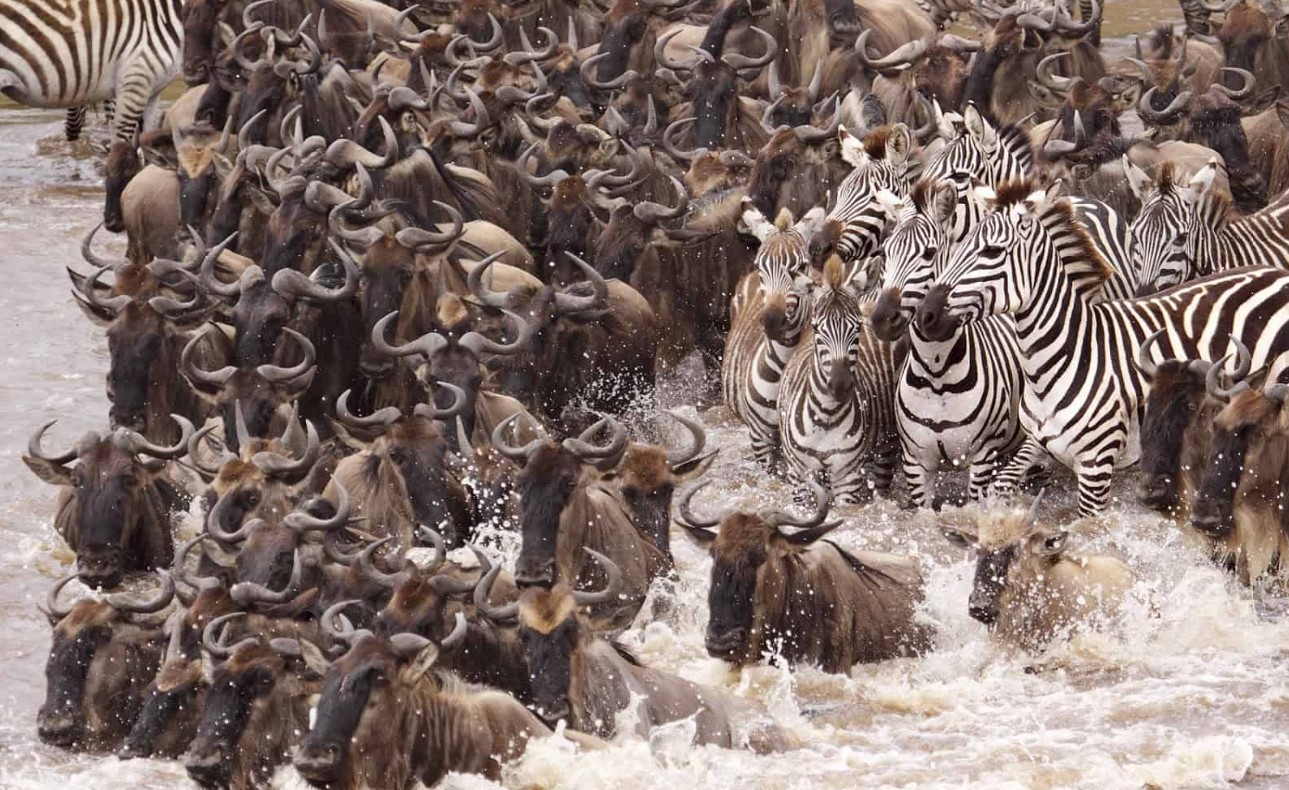
The Great Wildebeest Migration
The Great Wildebeest Migration: Across the Arusha Serengeti plains, nearly two million animals migrate at once during the Great Wildebeest Migration, one of the most breathtaking wildlife spectacles. It is the biggest animal herd movement on Earth, sometimes referred to as just “The Great Migration.” The density of the wildebeest population is so great that it is visible from space, with up to 1,000 animals per km2. Continually moving in long lines in search of water and grazing, columns of wildebeest are accompanied by a variety of companions. Because wildebeest are endemic to the Serengeti plains and are herbivores, lions are also frequently seen in Tanzania’s Serengeti National Park and the Maasai Mara.
What is known as the Great Wildebeest Migration?
This term describes the annual, vast migration of more than 1.5 million wildebeests, hundreds of zebras, antelopes, and gazelles in quest of grass and water. The migration covers a distance of 1900 kilometres (about 1200 miles).
Fascinating facts about the Great Wildebeest Migration
Dramatic scenes abound along the route as thousands of creatures are slain by predators and thousands more are born, reviving the population and maintaining the circle of life. The wildebeest spend the majority of their life grazing on plains, but once a year, more than 1.5 million of them embark on what is known as the Great Wildebeest Migration. One of the “Seven Wonders of the Natural World” is now this yearly migration northwest, which occurs at the end of the rainy season, generally in May or June. They migrate in quest of greener pastures, fording numerous rivers teeming with crocodiles and coming across various hazards.
How the wildebeest overcome every obstacle in their path is a matter of imagination. Some who specialise in nature say that their actions are driven solely by their urge for survival. The wildebeest covers an amazing 800–1,000 miles during their migration. Though it is still unclear how they know which way to go, it is generally accepted that their route is determined mostly by how they react to the weather; they follow the rain and the emergence of new grass. And this is only one of the countless amazing details regarding the Great Wildebeest Migration.
Although there is not any scientific evidence to support it, some experts think that the creatures respond to distant thunderstorms and lightning. It has even been proposed that rain is detectable in wildbeests from almost 50 kilometres away. The movement is a feast for predators, including crocodiles, wild dogs, lions, leopards, cheetahs, and hyenas. The Great wildebeest Migration has earned the moniker “the greatest show on Earth” thanks to the spectacle of game and prey.
There are several hazards on the trek, with slow-moving calf taken by lions and other predators. Due to the steep river slopes they must traverse, even the hardest wildebeests are not safe. It is rather amazing to witness the abundance of predatory crocodiles in the waterways, as you may guess.
The route takes the animals from Tanzania’s southern Serengeti Ngorongoro Conservation Area (not into the Crater itself) up through Tanzania‘s Serengeti and across into Kenya’s Maasai Mara and back. The savannah grass maintains an amazing symbiotic balance with the diverse grass-eating habits of zebra, gazelles, and wildebeest.
Certain animals only consume the uppermost portion of the tallest grass, while others nibble on the middle-height grass and even uproot the remaining portion. This type of grazing makes it possible for the Serengeti’s savannah grass to flourish abundantly again.
Best time to see the Great wildebeest migration
The best time to see the great wildebeest migration is mainly in January. The Great Wildebeest Migration moves into the Ngorongoro Conservation Area by travelling south along the eastern fringe of the Serengeti. The crater is where the wildebeest nurse their newborn calves since it provides exceptionally nutritious grass for calving and is a pleasant, romantic setting. Just think about how romantic the Ngorongoro is: in just two to three weeks, at least 400,000 calves are born, meaning that 8,000 calves are lost every day.
The Ngorongoro crater’s birthing season is regarded as the beginning of the migration. The herds go to the short-grass plains on the northern, gently sloping Ngorongoro Crater about late January or early February. Just when the herds are full with young, predators swoop. Bloodthirsty tourists should visit Arusha during this time of year, as hunting is quite easy and it is a spectacle to watch lions, cheetahs, and leopards feasting.
Following the best time to see the great Wildebeest migration, the low season offers the best deals on flights, accommodations, and travel—just something to think about. The central Serengeti’s greener grass is the destination for the wildebeest as they head northwest in April. A multitude of antelope groups and thousands of zebras join them. In the latter part of May, the mating season gets underway, and the wildebeest cover several km over the Serengeti.
